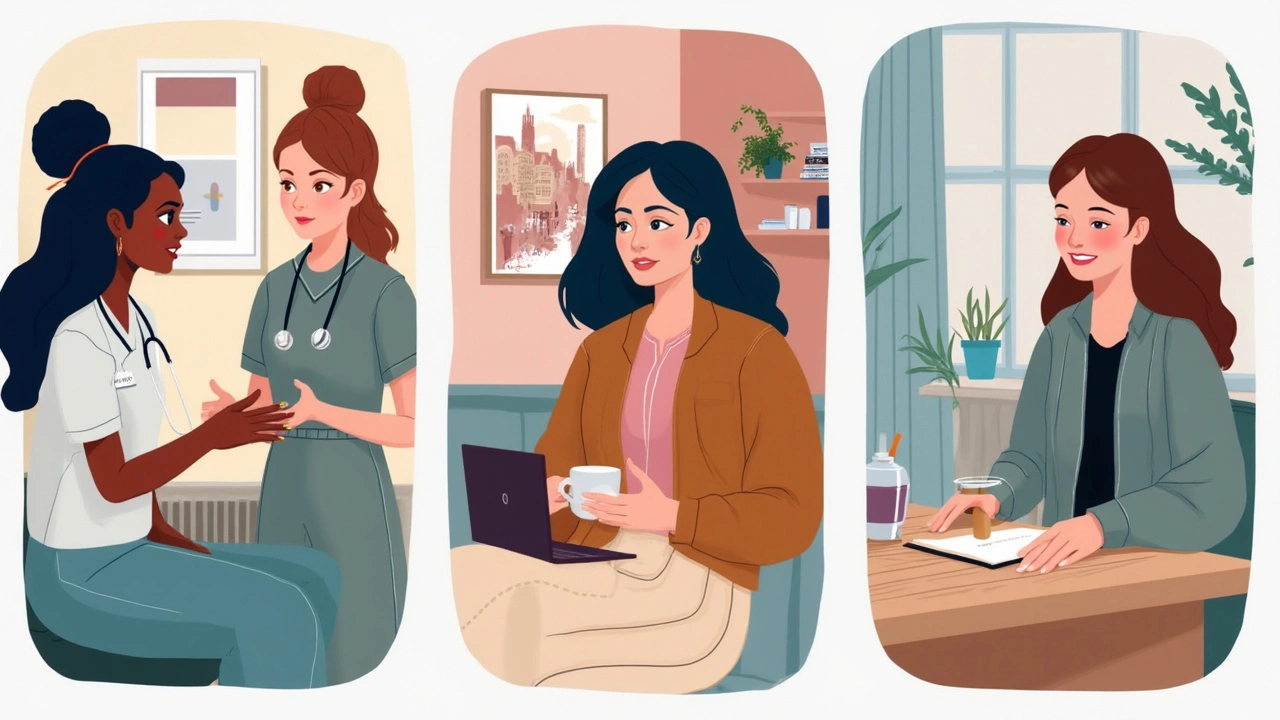Think the idea of a "female Viagra" is old news? The search for a magic fix for low sex drive in women is not even close to over. It’s complicated, too—way trickier than the male side of things. Flibanserin, branded as Addyi, is usually at the center of these conversations. It’s marketed as a game-changer for women dealing with Hypoactive Sexual Desire Disorder (HSDD). The hype is real, but so are the debates. This isn’t just about a pink pill on the nightstand; it’s tangled up in medicine, stigma, and real-life expectations. Why are the facts about Flibanserin so murky? Let’s get into the nuts and bolts, the science, the drama, and stories from women who’ve actually tried it.
What Exactly Is Flibanserin and How Did It Get Here?
Flibanserin wasn’t always dressed in pink. It was first cooked up as a possible antidepressant in the early 2000s, but the mood boost didn’t pan out, so researchers noticed something else: some women in the studies said they felt friskier. That’s how the conversation shifted from blue mood to libido. Fast-forward to 2015, and after two FDA rejections and a heated fight over gender fairness in sexual medicine, Addyi scored approval as the first prescription drug for female sexual interest/arousal disorder in premenopausal women.
Addyi isn’t a hormone. It’s a daily pill, unlike Viagra (used as needed before sex). Flibanserin works by tinkering with neurotransmitters in the brain—namely, it lowers serotonin a little and bumps up dopamine and norepinephrine. These chemicals mess with desire, so the theory goes: more of the good, less of the brake pedal, equals more interest in sex.
| Fact | Details |
|---|---|
| Approval Year | 2015 (United States) |
| Brand Name | Addyi |
| Dose | 100mg once nightly |
| Target Group | Premenopausal women with HSDD |
| How Fast It Works | 60+ days for noticeable effects |
The journey wasn’t smooth. The FDA demanded more safety data, especially around drinking alcohol while on Flibanserin (the short version: don’t mix them, ever). Serious risks were flagged, like fainting and dangerously low blood pressure in some women. In short: Flibanserin is not a care-free fix and it’s not meant for every woman who has an off week in the bedroom. The approval process is a twisty story on its own—it was so controversial that even now, people still argue if it should be available at all.
What Problems Is Flibanserin Supposed to Fix?
We’re not talking about someone who’s just tired, or who’s not into their current partner—this goes much deeper. Flibanserin is prescribed specifically for HSDD, which is a mouthful for what boils down to a real medical diagnosis: ongoing lack of sexual desire that’s upsetting to the woman, and not caused by another issue (like depression, relationship trouble, or meds).
Doctors don’t just hand it out to anyone who asks. You need to run through a whole checklist:
- Is this plainly about low sexual desire, not pain, arousal trouble, or relationship drama?
- Is the loss of interest persistent – for at least 6 months?
- Is it actually a problem for you, or just someone else’s expectations?
- Ruling out everything else: meds, mental health, medical conditions.
The first thing to know is that low sex drive is normal sometimes. It happens to everyone. Only when it’s really upsetting your life and there’s no obvious outside reason do most experts suggest looking at something like Flibanserin. That’s also what makes this whole topic so loaded—there’s a risk of “medicalizing” normal ups and downs, especially for women, thanks to old-school cultural double standards.
It’s not for postmenopausal women. And it’s not for men at all. Also, there’s no crossover with big-name drugs like Viagra or Cialis—those treat physical arousal, not desire. Flibanserin is more about the mental side of things, and that can be frustrating for women who expect a spark to turn on overnight. It also means results can be subtle—or nothing at all, for a lot of women. If you like hard numbers: In clinical trials, women taking Flibanserin reported an average of 0.5 to 1 more "sexually satisfying events" per month compared to placebo. Not exactly the fireworks people imagine.

How Flibanserin Works in the Brain (and Why It’s Not Magic)
Most of us know that sex drive isn’t just about turning on a switch “down there.” It’s a tangled web of hormones, neurotransmitters, reactions to stress, body image, relationship dynamics and a bunch of things scientists can’t even agree on yet. Flibanserin basically walks into this chaos and tweaks serotonin, dopamine and norepinephrine activity.
Serotonin typically acts as a "brake" on sexual desire. Flibanserin cuts back a little on this. Dopamine and norepinephrine ramp up the "gas pedal." In theory, shifting this balance means you might feel more interested in sex. But brains are messy, not math equations. Some women notice a bump in desire; others get no boost. And some feel side effects instead, sometimes before any benefits show up.
There’s a catch: Flibanserin needs to be taken every night, and most women don’t feel anything happen until they’ve stuck with it for at least two months. You can’t pop one before a romantic evening and expect fireworks. It’s more like inching up a slope, hoping for steady progress rather than a sudden jump.
One survey published by JAMA in 2017 showed that only about 10% of women who tried Flibanserin stayed on it for more than a year. The reasons were mixed: some said it didn’t work, others couldn’t deal with side effects, and plenty were frustrated with the strict “no booze” rule. If you’re wondering, doctors warn that drinking alcohol while using Flibanserin greatly increases the risk of dangerously low blood pressure and fainting—to a point where Addyi’s prescriber and pharmacy must both register and warn every patient.
Possible Side Effects and Precautions—What You Need to Know
Here’s what you don’t see in commercials: Flibanserin comes with a list of side effects. Some women feel fine, some don’t. Common side effects include:
- Dizziness—especially when standing up suddenly
- Sleepiness and fatigue (a lot of women feel knocked out by it—hence the nighttime dosing)
- Nausea
- Dry mouth
Rare but scarier risks are severe low blood pressure or fainting, especially if you mix with alcohol or certain meds (like some antifungals and antibiotics). Because of this, doctors usually run through a checklist of everything you take before writing a script for Flibanserin.
Not surprisingly, the whole no-alcohol rule is the hardest for many to stick with. Flibanserin and booze simply do not mix. There's also a reason this drug is only for women who aren’t pregnant, breastfeeding, or postmenopausal: those groups were never tested in the main studies, so no one really knows if Flibanserin is safe or helpful for them.
Here’s a summary of side effects and stats (from a meta-analysis of clinical studies):
| Side Effect | Approx. % of Users Affected |
|---|---|
| Sleepiness | 12% |
| Dizziness | 10% |
| Nausea | 10% |
| Fatigue | 9% |
| Dry Mouth | 2-3% |
| Fainting/Loss of Consciousness | 0.3% |
Want a tip that doctors share? Set an alarm, take Addyi right before bed, and be ready for a full night’s sleep—driving after taking it is a no-go. Don’t double up on doses if you forget (just skip and try again tomorrow). And always keep every other medication, supplement, and glass of pinot far away from your Addyi routine.

Women’s Real Experiences: Does Flibanserin Work and Is It Worth Trying?
For most women, the question
Jasmine Hwang
June 28, 2025 AT 15:44Josh Gonzales
June 30, 2025 AT 10:34Caroline Marchetta
July 2, 2025 AT 05:21Akintokun David Akinyemi
July 2, 2025 AT 22:34Karen Ryan
July 3, 2025 AT 06:09Jack Riley
July 4, 2025 AT 05:43Jacqueline Aslet
July 5, 2025 AT 02:52Valérie Siébert
July 5, 2025 AT 18:23Kaylee Crosby
July 6, 2025 AT 00:45Adesokan Ayodeji
July 7, 2025 AT 01:53Terry Bell
July 7, 2025 AT 21:26Lawrence Zawahri
July 9, 2025 AT 14:09Benjamin Gundermann
July 9, 2025 AT 16:23katia dagenais
July 11, 2025 AT 07:10